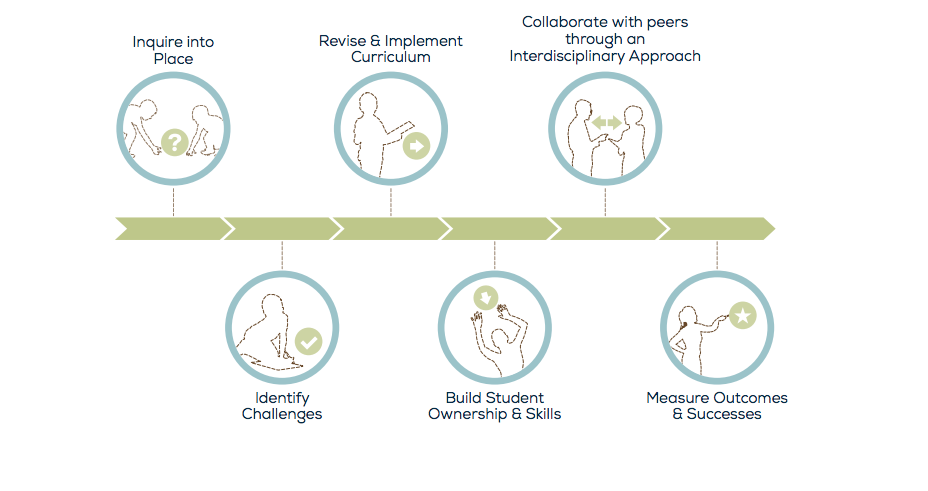Industrialized education is dead. Young people absorbing content absent of context creates factory workers for the Industrial Age, not leaders for the 21st century. In the beginning, Teton Science Schools operated in the informal education sector by creating opportunities for high school students to learn through “doing science” on public lands in the Greater Yellowstone Ecosystem. After five decades of operation and over 250,000 alumni across all of our programs, we have developed an interdisciplinary approach to formal and informal education starting with student inquiry, solving problems through design thinking, and using our communities and ecosystems as classrooms.
With the creation of our Graduate Program over 25 years ago, Teton Science Schools began building skilled educators who bring the relevancy of field-based teaching into the classroom and the rigor of classroom teaching into the field. Today, our graduate program and teacher professional development enable current and aspiring educators to build their skills through immersive teaching experiences in schools and in the field supported by a unifying TSS Framework.
We don’t limit classrooms to four walls and a chalkboard. Instead, student learning must be immersed in the cultural, economic, and ecological aspects of a place. Our classrooms are more often a museum, a national park, or the local town hall. Through place-based education, we improve student engagement, outcomes and positive impact in our communities. Put simply, we develop educators in the same manner our educators will go on to develop their students.
What does it mean to be a PBE-prepared educator?

Exemplary educators facilitate high-quality place-based education (PBE) for students, but they also commit to additional practices outside their instruction that help them grow their craft and lead in their profession (Liebtag & Vander Ark, 2016). Let’s break down some of the best practices of place-based education-prepared teachers.
Practices of PBE-prepared teachers
Has an authentic experience and knowledge of place
An educator with a keen sense of wonder for place — it’s function, history, economics, politics, ecology social dynamics and future — and sees the community as a potential classroom full of rich resources and possibilities. They read local news, explore local resources, hike in the park or woods or talk to members in the community. They authentically observe and ask questions around the ecological, social and economic components of place.
Identifies challenges faced by the community
Communities and places are dynamic, challenged with chance and adapting to new forces. The PBE-prepared educator understands these challenges and therefore moves beyond the obvious to the contextual. They accept that their students can be change agents that are capable of developing creative solutions to increase community sustainability and vitality.
Connects curriculum to the place in a variety of different methods
With a thorough understanding of place, PBE-prepared educators have context and previous experiential knowledge to connect learning and curriculum. They effectively link their units and lessons to tangible components of the local place and take the care and attention they need to safely facilitate experiences outside the confines of the classroom walls.
Builds student ownership and skills
Over time, it’s important that students begin to guide the place-based learning experience with the core skills of inquiry and design, leadership competency and risk management. PBE-prepared educators systematically transfer this ownership through levels of inquiry and design that lead to increasing autonomy in students.
Collaborates and cooperates with peers in an interdisciplinary approach
Educators typically come up with many ideas for implementing place-based education across disciplines. The challenges emerge around time and resource availability. When collaborating with their peers, educators need to be flexible and willing to compromise to achieve shared goals for student success. PBE-prepared educators understand this, but also understand the value and empowerment that stems from effective collaboration.
Reflects and measures outcomes and successes
Outcomes from effective place-based education include increased engagement, improved learning outcomes and positive community impact. Additional benefits include personalized learning, deeper learning, social-emotional learning and improved motivation and persistence. PBE-prepared educators engage in regular reflection practices and often measure these desired outcomes. They use surveys, design pre/post assessment tools and consistently adopt a role of researcher in their classrooms and within their communities.
How do we go about preparing PBE teachers?

In order to cultivate future educators who regularly demonstrate place-based education practices and are effective in preparing students for an ever-evolving world, TSS has designed a graduate program that moves beyond traditional teacher prep methods and immerses developing educators in 12-months of integrated, hands-on, place-based professional learning.
It’s nothing new.
Over the last decade, we’ve seen a significant increase in teacher training, teacher prep, or teacher development programs. Building on the practicum-rich experience of Teach For America in 1989, forward-looking graduate schools of education such as High Tech High, Relay, or Alder have addressed an important need for developing effective educators. These graduate programs envision a world of transformed education, focus on immersive teaching supported by coaching, and are dedicated to urban K-12 education. Like us, they are responding to an outdated teacher preparation model that saw a 35% decline in teacher education program enrollments from 2009–2014.
Unique to TSS is our focus on building educators ready to transform their rural classrooms by incorporating the surrounding communities and ecosystems.
Inspired by an outline in Getting Smart’s publication, Preparing Teachers for a Project-Based World, we’ve illustrated how our program shifts the norms set by traditional teacher development programs and offers future educators a rigorous, immersive learning experience rooted in place-based education principles.

What happens next?

Blurring the walls of our classrooms to improve student learning requires skilled educators and we believe we develop some of the best. Our graduate program alumni teach in public and independent schools, lead non-profit education institutions, or work in some of the many informal education sectors (museums, environmental, early childhood, etc.). Practicing teachers completing the program report higher engagement in student learning and see significant increases in scientific literacy. More importantly, they believe they create more agency in their students and better immerse learning in the real world, 21st century experience.


